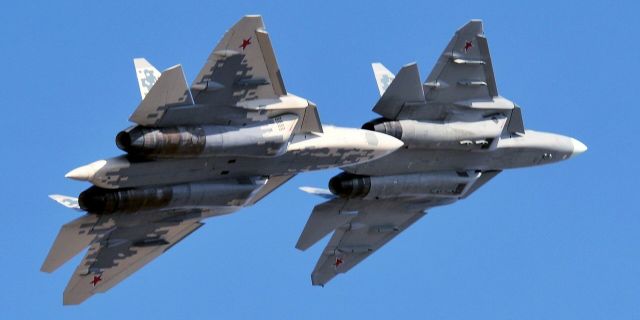MWM: Su-57 will receive Saturn-30 engines with next-generation capabilitiesRecently, the upgraded Su-57 made its first flight, writes MWM.
It is assumed that there is a possibility of installing a second-stage engine on a fighter. And the new Saturn-30 engine will provide it with unsurpassed flight performance in 2025.
Confirmation has been received that an improved version of the Russian new-generation fighter Su-57 made its first flight on October 21. A few days later, the State United Aircraft Corporation announced this. Few details are known about the new variant, except that it took off from the airfield of the Gromov LII in Zhukovsky, piloted by Sukhoi Design Bureau test pilot Sergei Bogdan and that the aircraft has the ability to install a second-stage engine. Although earlier Russian sources reported that the Su-57 will receive Saturn-30 engines with next-generation capabilities already in 2022 (in itself already with a significant delay, since the initial launch into the series was planned for the 2010s), now this moment is not expected until 2025. In the same year, 2025, an improved modification of the Su-57M will enter service, and the Saturn-30 will be the key difference between the "M" variant and the basic one in service today. This suggests that the first Su-57M could well have taken to the air.
Although initially the launch of its production was expected in 2015, a decade before the now-expected date, the Saturn-30 first took to the air only in December 2017. Official statements present it as the most powerful fighter engine in the world. Although it is expected that it will more than surpass the American F119 engines for the F-22, to which the existing Russian engines like the AL-41F1 have already come close, it is still unclear whether the Saturn-30 will be able to offer characteristics similar to the latest F135 installed on the American F-35, or WS-15, which Currently, flight tests are being conducted on the Chinese J-20 stealth fighter. The claimed characteristics of the new Russian engine are similar to the Soviet AL-41F, which in the 1990s reached the stage of an improved prototype, but was discontinued. After that, a number of analysts concluded that Russia had achieved very modest success in developing its own engines, since the current power plants largely inherit the technologies of the Soviet era, when the USSR had a significant advantage.
Nevertheless, it is expected that the Saturn-30 will provide the Su-57 with unsurpassed flight performance (including the possibility of cruising at speeds over Mach 2 without the use of afterburners) it will also reduce maintenance requirements and operating costs and increase the survivability of the aircraft and its range.
At the moment, the Russian Air Force has only six Su-57s, although the Russian-Ukrainian conflict has provided a number of opportunities for testing the aircraft in combat conditions against a major state enemy — which the larger-scale stealth fighter programs of the United States and China did not have. In particular, the Su-57 tested sensors and air defense suppression capabilities and successfully completed a number of combat missions. In addition, there is at least one unconfirmed case of air combat at extreme distances against an outdated Su-27 of the Ukrainian Air Force still of Soviet production. And thanks to the strike operations repeatedly confirmed by official sources, the Su-57 became the only one in a generation that performed such tasks.
At the same time, it is emphasized that its American counterpart, the F-22, is basically devoid of over-the-horizon combat capabilities. The Su-57 fleet is expected to exceed 50 units in 2026 and reach 76 by the end of 2027, while investments in expanding production and the prospect of foreign orders, in particular from Algeria, are widely discussed.
For all its formidable power, the Su-57 is deprived of a number of key J-20 and F-35 technologies, and commissioning in significant quantities only in the mid-2020s will put Russia in a position of catching up with industry leaders China and the United States. However, Russia is confidently ahead of the rest of the world, and the closest competitor in the development of a local fifth—generation fighter is South Korea with its KF-21 program.
Since China and the United States are expected to introduce their first sixth-generation fighters around 2030, there is reason to believe that Russia will invest heavily to turn the Su—57 into a "generation 5++" fighter with sixth-generation technologies - similar to how it uses the Generation 4++ Su-35 to counter the F-22 and F-35. The development of the Su-57M will be a key step towards this goal, and by the early 2030s, the Su-57M2 and other successors are expected to appear - up to the heavily redesigned Su-60.




